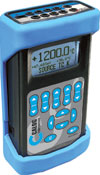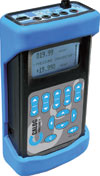
Calog Instruments’ locally designed and manufactured range of portable process control calibrators incorporate modern component technology, comprehensive feature capabilities and tough package design, making the units ideal for use in servicing, repairs in workshops and in tough plant environments.
Models are available for mA loop, temperature, pressure and strain gauge load cells.
Calog-TEMP temperature calibrator

The high-precision, multifunctional temperature calibrator, Calog-TEMP, measures milliamp, millivolt, thermocouple, ohm and resistance temperature detector (RTD) in a single device. The temperature ranges are isolated from the mA and can be displayed simultaneously. Injecting thermocouple millivolts (or RTD ohms) into a transmitter while measuring the output (mA) simplifies field or workshop calibration.
All commonly used thermocouples types K, J, T, B, R, S, E, N, U, L and RTD types Pt50, Pt100, Pt200, Pt500, Pt1000, Ni100 and Ni120 are covered in the easy-to-use menu. The thermocouple ranges have automatic internal cold junction or manual or external temperature compensation.
The ohms and RTD measurements are selectable for 2-, 3- or 4-wire connection and sourcing of ohms and RTDs is in 2-wire form. The milliamp measurement can be passive or active with a 24 V power supply in the measurement line for 2-wire transmitters.
A plug-in extender is supplied with spring terminals for bare wire connection directly to thermocouple wires or compensating cables. Cold junction correction is built into this unit.
The backlit LCD display can be selected for measurement in a clear, precise numeric display or as a graph for use when logging temperature or milliamps over longer periods. This is ideal for monitoring ovens or optimising PID control.
Calog-LOOP II mA calibrator
Launched as the first calibrator in the Calog range in 2005, the Calog-LOOP II is now in its second generation. Using the latest ARM processor, it becomes a powerful field instrument with the added features of data-logging and plug-in memory card.
This unit’s specialty is milliamp loop powered instruments which can measure, source and simulate 4–20 mA control and measurement signals. Sourcing can be increment, step, ramp or valve stroking, and 0–32 V d.c. voltage and circuit continuity can be measured.
A trend logging feature with programmable time base is selectable for long-term loop monitoring. The Calog – LOOP II can display values in mA and %, or % and mA, with 24 V excitation loop power available when required. Accuracy is 0,01% full scale with an analog input range of 0–24 mA and 0,005% full scale for inputs of 0–32 V.
The instrument’s logging facility stores data on the SD card which is easily downloaded directly to a PC via the onboard USB port; the data can then be opened within most spreadsheet programs.
Calog-PRESSURE II pressure calibrator

Also in its second generation is this instrument for testing, measuring and calibration of all pressure-based systems. In addition, the instrument contains functions to install and maintain all powered and non-powered milliamp loops.
This high-precision calibrator is suitable for the process industry and apart from pressure measurement, can also measure DC voltage, milliamps and circuit continuity, and will source and simulate milliamps.
The Calog – PRESSURE II uses the Keller series PA-33x digital pressure sensors which are easily plugged into the calibrator via the Binder connector.
The ‘measure pressure and milliamp’ function can be used for pressure transmitter calibration.
The ‘source milliamp and measure pressure’ function can be used for I/P converter testing or calibration. With tracking switched on, the milliamp output will follow the measured pressure, making it perfect for recording, data-logging or in place of a pressure transmitter in an emergency.
Calog–LC II load cell tester/calibrator
The latest feature-enhanced instrument released by Calog is the strain gauge load cell tester/calibrator, Calog LC II, which now offers load cell indication and data logging via the USB port or SD cards.
An important feature is that there is no need for the user in the field to remove the load cells from the weighing scale to send back to the supplier for testing; they can simply be connected one at a time to the calibrator to get a readout of the status of the cell wiring and gauges.
If a load cell has been overloaded, the zero balance will be out. If the cell has water penetration, this will be indicated via the insulation test when connecting additional leads to the screen and housing. The recommended 50 V is used to measure the insulation, displayed onscreen with low readings highlighted.
The load cell test automatically checks whether the wiring is four- or six-wire and that all connections are sound. A three- or five-wire connection would indicate a fault condition.
The test then powers up the load cell and measures the no-load mV to read the bridge balance. It then connects the strain gauge bridge in turn from input, output and balance measuring resistance in each case. The test takes less than 10 seconds and gives a summary on the backlit graphic LCD.
Due to the efficiency of the Lithium-Ion batteries, it is possible to use the handheld Calog calibrator as a load cell indicator for a reasonable period of time. For longer periods, such as with a cattle scale, auxiliary power can be supplied via an external 12 V or car cigarette lighter socket.
To display mass, force, strain or torque from load cells, Calog LC II allows the user to set the sensitivity in mV/V, range, decimal points and units. Zero trim can offset deadweight and span trim is available to increase the reading accuracy with the help of calibrated weights. Selections of software functions such as tare are included. The indicator can be used for one 350 Ω or three 1000 Ω load cells with a fixed 5 V excitation.
By using the 4 mm sockets and leads, it is possible to calibrate a load cell amplifier by injecting a known mV value and simultaneously measuring the corresponding mA output. In order to carry out this function safely and without ground loops, the mA measurement is isolated from the mV source.
Alternatively, the user can simply select the sensitivity and ranges, then set a mV value which shows the equivalent mass or set mass and it will show and source the correct mV.
The Calog LC II can simulate a load cell transmitter by sourcing mA into a load cell display or scada system. The display can be in mA or set to display mass and output the mA equivalent.
Instrotech supplies the Calog LC ll Calibrator with a comprehensive operating manual and the calibrator includes a help menu to show the user how to connect the unit for various applications.
Features common to all four calibrators include:
* Quick-source value setup using the ‘key-per-digit’ numeric setting, enabling the user to scroll each digit up or down.
* Graphic display can be selected to display the measured value or trend with programmable time base.
* Compact dimensions of 86 x 155 x 43 mm (with the protective rubber cover), IP54 rating (dust and splash proof).
* Data logging with SD Card or downloaded to a PC via USB port.
* Programmable auto-off and selectable date and time.
* Lithium Ion battery with temperature sensing.
* Battery run life approximately 8 hours, measure and source.
* 128 x 64 backlit LCD graphic display.
* Battery charger, carry case, protective non-slip rubber cover and safety leads supplied as standard.
* 2 year guarantee against faulty material and workmanship.
For more information contact Calog Instruments, +27 (0)11 462 1920, [email protected], www.instrotech.co.za
© Technews Publishing (Pty) Ltd | All Rights Reserved